What is the Average Price of an E-bike?
Introduction
E-bikes, or electric bicycles, have gained tremendous popularity in recent years due to their eco-friendly nature, convenience, and cost-effectiveness. As people increasingly seek sustainable transportation options, the demand for e-bikes has surged. However, potential buyers often wonder about the average price of an e-bike and what factors influence their cost. In this article, we will delve into the various factors that impact the price of an e-bike and provide an insight into the average price range you can expect.
Understanding E-bike Pricing Factors
1. Battery and Motor
The core components of an e-bike that significantly influence its price are the battery and motor. High-quality lithium-ion batteries and powerful motors contribute to better performance and range, but they also increase the cost. E-bikes equipped with the latest battery and motor technology are often priced at the higher end of the spectrum.
2. Design and Build Quality
The design and build quality play a crucial role in determining an e-bike’s price. E-bikes designed for specific purposes, such as mountain biking, urban commuting, or cargo hauling, may come with specialized features and materials, which can impact their cost. Bikes with premium build materials, like carbon fiber frames, are generally more expensive than those with aluminum or steel frames. https://www.theebikespecialist.com.au/electric-bikes-fremantle/

3. Brand Reputation
Established and reputable e-bike brands often command higher prices due to their track record of delivering reliable and well-designed products. These brands may also offer better warranties, customer support, and after-sales service, which add to the overall cost of the e-bike.
4. Technology and Features
Advanced technology and innovative features also contribute to the price of an e-bike. Integrated smart displays, regenerative braking systems, GPS tracking, and mobile app connectivity are examples of premium features that can elevate the cost.
5. Range and Performance
E-bikes with longer ranges and higher performance capabilities generally come with a higher price tag. The ability to travel further on a single charge or achieve faster speeds can be appealing to some consumers, justifying the higher cost for them.
6. Market Demand
The basic principles of supply and demand also affect e-bike pricing. If there is a high demand for a particular model or brand, the price may be driven up. Conversely, when the market is saturated with options, it can lead to more competitive pricing.
Average Price Range of E-bikes
The average price of an e-bike can vary significantly depending on the factors mentioned above. As of the time of this writing, here is an approximate breakdown of e-bike price ranges:
1. Budget-Friendly E-bikes: $500 – $1,500
At the lower end of the spectrum, you can find budget-friendly e-bikes that offer basic features and entry-level components. These bikes are suitable for casual riders and short-distance commuting but may lack the power and range needed for more demanding use.
2. Mid-Range E-bikes: $1,500 – $3,000
In the mid-range category, you’ll find a wide variety of e-bikes with better battery capacity, improved motors, and additional features. These bikes are a popular choice for commuters and recreational riders who seek a good balance between performance and affordability.
3. Premium E-bikes: $3,000 – $8,000+
At the higher end of the price spectrum, premium e-bikes come with top-of-the-line components, cutting-edge technology, and exceptional build quality. These bikes cater to enthusiasts, professionals, and riders who prioritize top-tier performance, advanced features, and luxurious designs.
Additional Costs to Consider

When purchasing an e-bike, it’s essential to consider other potential costs that may arise:
1. Accessories
Accessories such as helmets, locks, racks, and lights are essential for enhancing your e-bike riding experience. While they may add to the initial cost, investing in quality accessories ensures safety and convenience.
2. Maintenance and Repairs
Like any other mode of transportation, e-bikes require regular maintenance and occasional repairs. Factor in these costs to ensure the longevity and optimal performance of your investment.
3. Insurance
Depending on your location and e-bike model, you may need to invest in insurance coverage to protect your e-bike from theft, damage, or accidents.
Conclusion
The average price of an e-bike can vary widely based on factors such as battery and motor quality, design, brand reputation, technology, and performance capabilities. Budget-friendly e-bikes offer a cost-effective entry point into the world of electric bicycles, while premium options provide top-tier features and performance for avid riders. Understanding these pricing factors will help you make an informed decision and find an e-bike that aligns with your budget and riding needs. Remember to also consider additional costs such as accessories, maintenance, and insurance to ensure a fulfilling and hassle-free e-bike ownership experience.




